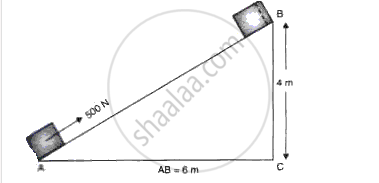Advertisements
Advertisements
प्रश्न
A block of mass 20 kg is pulled up a slope (fig.12) with a constant speed by applying a force of 500 N parallel to the slope. A and B are initial and final positions of the block.
(a) Calculate the work done by the force in moving the block from A and B.
(b) Calculate the potential energy gained by the block.

उत्तर
(a) given force = 500N
Vertical displacement = Final position - initial position = BC = 4m
work done = force x displacement = 500 x 4 = 2000J
(b) P.E gained = mgh = (mg) h = 500 x 4 = 2000J
APPEARS IN
संबंधित प्रश्न
In each of the following a force, F is acting on an object of mass, m. The direction of displacement is from west to east, as shown by the longer arrow. Observe the diagrams carefully and state whether the work done by the force is negative, positive or zero.

Express joule in terms of erg.
A box of weight 150 kgf has gravitational potential energy stored in it equal to 14700 J. Find the height of the box above the ground. (Take g = 9.8 N kg-1)
How much energy is gained by a box of mass 20 kg when a man, carrying the box waits for 5 minutes for a bus?
State two disadvantages of producing hydroelectricity.
How much work is done when a body of mass m is raised to a height h above the ground?
Define 1 joule of work.
What are the units of (a) work, and (b) energy?
A boy throws a rubber ball vertically upwards. What type of work, positive or negative, is done : by the force applied by the boy?
(a) by the force applied by the boy?
(b) by the gravitational force of earth?
A boy does work when he pushes against a brick wall. (yes/no).
What is the SI unit of work?
A man lifts a mass of 10 kg from the floor to a shelf 4 meter high. If g = 10 ms-2, what is the work done?
Can every force produce work?
Fill in the boxe to show the corresponding energy transformation.

State the energy changes which take place when A stone dropped from the top of a cliff reaches the ground after some time.
In what way does an ‘Ideal machine’ differ from a ‘Practical machine’?
